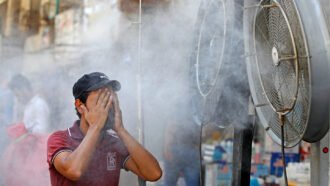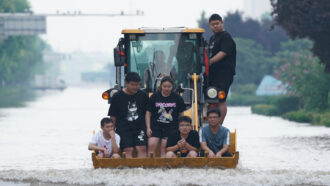Search Results

Climate Change Spikes Baseball Homers
Baseball fans love numbers and explaining every nuance of baseball statistics. In this Guide, students will learn how climate change is boosting home runs and study the physics behind the increase in homers.
How heat and home runs are connected
Students will answer questions about the online Science News article “Baseball’s home run boom is due, in part, to climate change,” which explores how increases in temperatures boost home run numbers. A version of the article, “Climate change spikes baseball homers,” appears in the May 6, 2023 & May 20, 2023 print issue of Science News.
Curbing Climate Change
The emissions of greenhouse gases through human activities are changing the world and making it warmer. But there are technologies and strategies that can reduce these emissions and slow climate change. In this activity, students will research methods of reducing carbon dioxide production and removing carbon from the atmosphere and present on their findings.
Lake scavenger hunt
Lakes can vary in color based on levels of sediment, organic matter and algae. Sometimes though, a lake will stand out – not matching the other lakes in an area. Look for these anomalies by participating in a virtual lake scavenger hunt, and help figure out why these lakes don’t fit in! In this activity, students will learn how climate change influences lake color and will investigate lakes with irregular colors that have been impacted by natural or human-made forces.

The Road to Net-Zero
Human activities pump a lot of greenhouse gases into the atmosphere, and those emissions are driving climate change. In this guide, students will review greenhouse gases and their sources and learn about ways to reduce emissions.
How to make the future climate-friendly
Students will answer questions about the online Science News article “It’s possible to reach net-zero carbon emissions. Here’s how,” which explores various solutions to decrease greenhouse gas emissions. A version of the article, “The road to net-zero,” appears in the January 28, 2023 issue of Science News.
Diagram the way to net-zero greenhouse gas emissions
Students will review, discuss and diagram atmospheric greenhouse gases and their impact on Earth. Then students will analyze a graph to begin thinking about what it will take to achieve net-zero emissions. Learning Outcomes: Reviewing greenhouses gases and their impact on Earth, diagramming human impact, understanding the idea of net-zero emissions.

How Much Heat Can We Handle?
Summers are getting hotter. Use this guide to help students explore the science of heat and its effects on the body, and then apply what they learn through diagramming.
Too hot to handle
Heat waves are becoming more frequent around the globe, and scientists are studying humans’ ability to endure the extra heat. Get students thinking about what it means to handle heat and explore basic thermodynamic concepts through diagramming. Learning Outcomes: Diagramming
Feeling the heat
Students will answer questions about the Science News article “Humans may not be able to handle as much heat as scientists thought,” which explores the effects of extreme heat on the body and what that means for us as heat waves intensify around the globe. A version of the article, “How much heat can we handle?” appears in the August 27, 2022 issue of Science News.
Thinking through climate solutions
Students will research how climate change affects a nonhuman species, propose science-based solutions that might lessen the impact of climate change on the species and create an infographic to share with the class.

Earth Cannot Avoid a Warmer Future
In this guide, students will learn about a United Nations assessment that concludes human-caused climate change is behind extreme weather events. Then, students will discuss and compare climate scenarios and visualize some of the data.